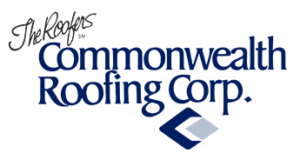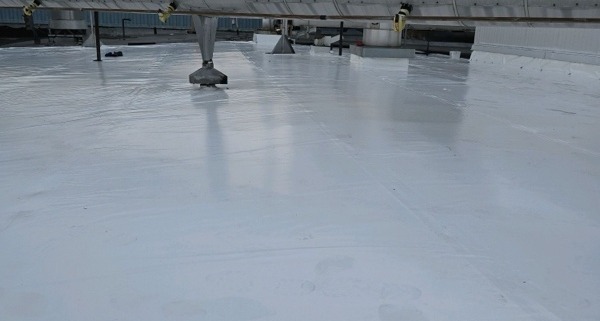Roof Replacement vs. Roof Layover: Which one is better?
Complete Roof Replacement vs. Layover Existing Roof: Which one is better?
Over time, your commercial roof will experience normal wear and tear, along with the possibility of damage from inclement weather. Regular maintenance and repairs will extend the life of your roof, but at some point, your roof will eventually reach the end of its useful life. At that point, you will face the decision on the wise thing to do. Most situations face two options: 1) a complete roof replacement or 2) a roof overlay. It may get damaged by weather and general wear and tear due to lack of maintenance, causing leaks and other structural issues. In such a situation, you have two options: complete roof replacement or a roof overlay.
Understanding the differences between both options is essential to ensure you choose the solution that best fits your roof’s needs and budget. In this article, we’ll explore Roof Replacement vs. Roof Overlay, discussing their pros, cons, and key differences. Let’s dig in!
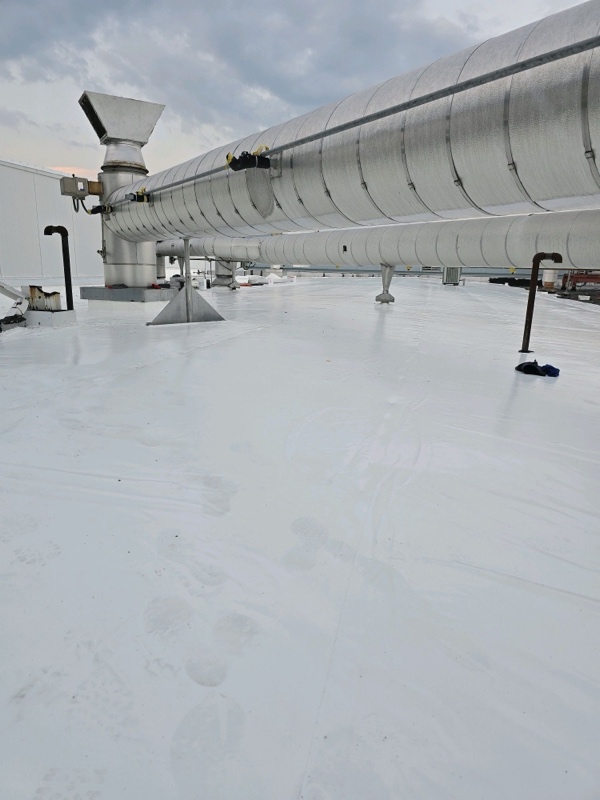
What is Roof Overlay?
Typically, roof overlay is the process in which another layer of roofing material is spread right on top of the existing roof. It’s also known as roof recovery. However, most states allow only a limited number of overlays. Be sure to check the local building codes before making a move. You can also contact an experienced contractor in your area, and they will oversee the installation per state and local building codes.
Advantages of Roof Overlay
Here are some pros of a roof overlay that many professional building owners consider before making a purchase decision.
Cost-Effective: Firstly, a roof overlay is quite cost-effective since you do not have to tear off all the old materials. This means your installation requires fewer labor hours, and you do not have to pay to dispose of the old roof material at the local landfill.
- Less Disruption: The roof layover is a faster and less intrusive process, which significantly minimizes the noise, dust, and mess that are typically associated with roof tear-off. It means you can resume your commercial business activities within a short period of time.
- Suitable for Quick Sales: If you are considering selling or renting your commercial property but poor roof conditions are becoming a barrier to securing good rates, roof overlays may be your answer. They are faster than roof replacement and provide your commercial building with an immediate boost in aesthetic appeal that’s sure to impress buyers, ensuring good quotes for your property.
- Warranty: A roof layover is very common in the marketplace and widely acceptable, and most manufacturers will offer a 15, 20, or 25 yr. Labor and Material Warranty on their products.
Downsides of Roof Layover
- Added Weight on the Roof: If the integrity of the roof decking is currently compromised, adding another layer of materials will increase the burden carried by the roof’s infrastructure. If the infrastructure is in poor condition, such as rotten wood, rusted metal, or saturated insulation, the extra weight could cause the roof deck to sag or, in extreme cases, collapse.
- Overlook Structural Issues: During an overlay, if the existing roof is not properly inspected, underlying structural issues could go unnoticed. Unwanted concealed damage, such as rotting wood, mold growth, and water damage, could remain hidden under the new roof. This may further worsen the roof condition over time, leading to expensive repairs down the road and possibly even business interruptions.
What is Roof Replacement?
Roof replacement, or roof tear-off, is when the old roofing material on your building is torn off down to the deck and inspected for any structural deficiencies. Then, an entirely new roof system is installed. The roofing contractor will review your existing roof and materials section-by-section, preparing your roof for the new roof system.
Advantages of Roof Replacement
- Identify Structural Issues: One of the most significant advantages of roof tear-off is the ability to inspect underlying structural issues fully. When contractors remove old materials, they can pinpoint hidden problems like rotting wood, leaks, and damaged insulation. This ensures that your new roof is installed on a solid foundation.
- Invest in Better Roofing Materials: Many older roofs are made using outdated and subpar materials. A complete tear-off allows you to upgrade to newer and more durable materials that are energy efficient, fire retardant, lightweight, resistant to animal fats and oils, easy to repair, and aesthetically appealing.
- Guaranteed Warranties: Most roofing contractors offer extensive Labor and Material Warranties, ranging from 15, 20, and even 25 years for newly replaced roofs. Most warranties are NDL (No Dollar Limit) and can even be transferable with the sale of the building.
Downsides of Roof Replacement
- Requires Proper Waste Removal: Roof tear-offs produce a lot of waste, such as old materials, underlayment, and nails. Some older roofs may have coal-tar pitch or even asbestos, so disposing of this mess takes a lot of time and resources.
- Quite Disturbing: A roof tear-off can be quite noisy and disruptive as it involves removing old materials. The demolition process can create a lot of dust and mess and possibly even disrupt business operations. Consequently, some businesses may have to modify their daily operations to accommodate the installation of a new roof.
Roof Replacement vs Roof Overlay: Head-to-Head Comparison
Now that you are aware of the pros and cons of both roof upgradation approaches let’s discuss the major differences in roof replacement vs roof overlay:
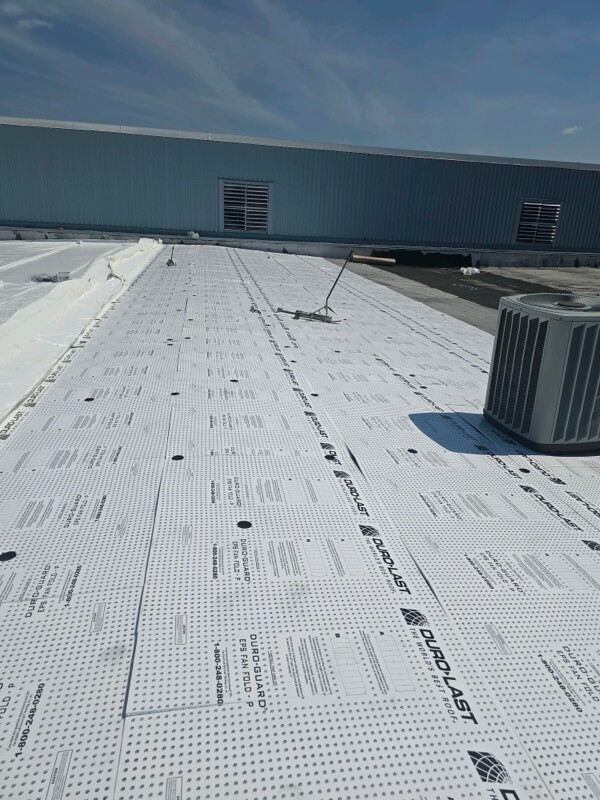
Longevity
- Both offer 15, 20, and 25-year warranties.
- Roof Overlay: In roof replacement vs roof overlay, the latter has quite a short lifespan since the older roof and structural issues remain in place. You can expect the overlay to last 10 to 15 years on average.
- Roof Replacement: On the other hand, a complete roof replacement offers better longevity. In this, roofers take care of all underlying issues, giving your building’s roof a fresh start. Typically, a new roof can last anywhere between 20 and 50 years.
Budget
- If the integrity of your roof has been maintained, and local and state building codes permit an Overlay on your roof system, there are considerable savings. An Overlay could easily be 50% less than a complete Roof Replacement cost.
- Roof Overlay: In roof replacement vs. roof overlay, the latter is a budget-friendly option, costing around $3,000 to $8,000. However, these numbers can significantly vary based on the size and condition of the roof. The savings can be short-term if structural issues arise later, demanding extensive repairs and roofing maintenance.
- Roof Replacement: Commercial roof replacement is quite expensive, costing around $7 to $15 per square foot, depending upon the type of materials you choose for your building and overall roof size. While the initial cost may seem high, you should know that it’s a long-term solution to all your roofing issues and requires minimum maintenance, saving money on future repairs.
Safety
- Roof Overlay: A roof overlay may seem a convenient option, but it’s a safety threat on a weakened roof. The additional weight of the new materials over existing ones can cause the roof to collapse, leading to severe injuries and even causalities. Statistics reveal that over 3,000 roof collapses in the US occur every year, resulting in national tragedies.
- Roof Replacement: Compared to roof replacement, roof overlay is a much safer option for your building. As roofers remove the old materials completely, they detect and fix underlying issues so your roof lasts for years without posing any safety issues.
FAQs
What is the most common type of commercial roof?
Metal roofs are one of the most common types of commercial roofs due to their ease of installation and extensive lifespan, which often exceeds 50 years, and that too with minimal maintenance. They are durable, offer excellent protection, and don’t burn if any unfortunate incident like a fire happens in the building.
What is the standard roof pitch for a commercial building?
Commercial building roofs can be steep, low, or even have no slopes. Their pitch ranges from 1/12 to 6/12. The rise and length of the roof typically decide the exact pitch for your commercial property.
What is the thickness of the roof slab for a commercial building?
Generally, a 4 to 6-inch slab thickness is ideal for commercial buildings, but this may vary depending on factors like local building codes and the type of reinforcement used.
What is a built-up commercial roof?
A Built-Up Roof (BUR) is made of multiple layers of ply sheets and asphalt and topped off using a cap sheet or a flood coating of asphalt. They are renowned for creating a durable, water-resistant surface that doesn’t let environmental elements like rainwater and snow seep into the roof system.
Conclusion
The choice between roof replacement and roof overlay depends upon many factors, including cost, long-term goals for the building, longevity, curb appeal, and special applications.
Consequently, if you are in the process of researching for an upcoming roof replacement or overlay, Commonwealth Roofing Corp has over four decades of experience helping building owners, property managers, and corporations navigate the process of planning your upcoming project. Contact us today to explore how we can work with you to discover the best roofing solution to meet your challenge, solve your problem, or reach your goal. Durable, sustainable roofing solutions are our specialty.
